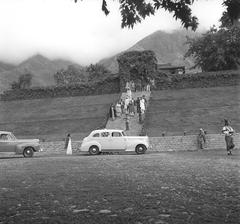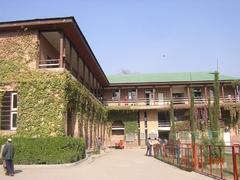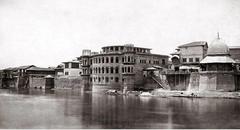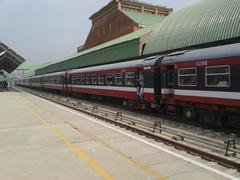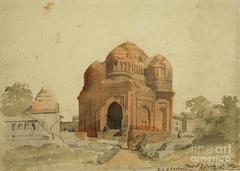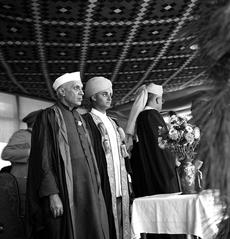Madin Sahib Srinagar: Visiting Hours, Tickets, and Historical Significance Guide
Date: 04/07/2025
Introduction
Located in the historic Zadibal and Alamgari Bazar areas of Srinagar, Jammu and Kashmir, the Madin Sahib Mosque and Shrine stand as enduring symbols of the region’s spiritual and architectural legacy. Established in 1448 CE under the patronage of Sultan Zain-ul-Abideen (Budshah), the complex honors the Sufi saint Syed Mohammad Madani, who played a pivotal role in shaping Kashmir’s religious and cultural landscape. Madin Sahib is renowned not only as an active religious site but also as a monument reflecting Kashmir’s cultural pluralism—blending Islamic, Persian, and indigenous Kashmiri design, with syncretic elements rooted in Hindu and Buddhist traditions.
The shrine offers free entry and is open to visitors throughout the day, making it an accessible destination for both pilgrims and tourists. Its location ensures easy connectivity with local transport, and the proximity of other notable sites such as Shankaracharya Temple, Hazratbal Shrine, and Dal Lake makes it a vital part of any cultural itinerary in Srinagar. Ongoing preservation and restoration initiatives, supported by governmental and community efforts, aim to safeguard this heritage site for future generations.
This guide presents a comprehensive overview of Madin Sahib’s history, architecture, visitor information, cultural etiquette, conservation status, and more. For the latest details on visiting hours, entry, and restoration, consult resources such as TravelSetu Srinagar Tourism, The Kashmir Horizon, and Kashmir RootStock.
Table of Contents
- Introduction
- Historical Origins
- Architectural Features and Syncretism
- Religious Significance
- Visiting Madin Sahib
- Preservation and Restoration
- Madin Sahib in Kashmiri Heritage
- Visitor Experience and Etiquette
- Nearby Attractions
- Frequently Asked Questions
- Conclusion
- References
Historical Origins
Madin Sahib Mosque was constructed in 1448 CE during the reign of Sultan Zain-ul-Abideen, a ruler celebrated for his patronage of art, culture, and religious tolerance. Dedicated to Syed Mohammad Madani, the Sultan’s spiritual mentor, the site reflects the flourishing of Sufism and communal harmony characteristic of the period (Native Planet). The establishment of the mosque and tomb was integral to the Sultan’s broader initiative to promote spiritual learning and social cohesion.
Architectural Features and Syncretism
Materials
The Madin Sahib complex is noted for its use of brick masonry and deodar wood—a choice dictated by Kashmir’s seismicity and abundant forests (Kashmir RootStock). Wood is extensively used in pillars, ceilings, and decorative screens, showcasing traditional Kashmiri craftsmanship.
Roofing and Structural Form
The mosque and tomb feature distinctive multi-tiered, sloping pagoda-style roofs, a hallmark of pre-Islamic Buddhist and Hindu architecture in the region. This design not only protects against heavy snowfall, but also visually ties the monument to Kashmir’s syncretic architectural heritage.
Decoration and Motifs
- Papier Mâché and Tile Work: The interiors display intricate papier mâché decorations (Kar-I-Qalamdan) with geometric and floral patterns, and walls are adorned with vivid tiles—a technique prominent in 15th-century Kashmir (Memeraki).
- Carved Woodwork and Stone: Exquisite carvings on wooden doors, ceilings, and pillars are complemented by rare stone animal motifs at the entrance, including a beast with a leopard’s body—an unusual feature in Islamic art, echoing Hindu and Buddhist iconography (Native Planet).
- Indigenous Motifs: Chinar leaves, lotus flowers, and almond shapes blend seamlessly with Islamic calligraphy, illustrating Kashmir’s unique artistic synthesis.
Syncretic Influences
Madin Sahib’s architecture incorporates elements from Buddhist and Hindu traditions—most notably, the pagoda roof and indigenous motifs—while adapting Persian and Central Asian features such as colored glass windows and frescoes to local materials and climate. The absence of domes and minarets further distinguishes Kashmiri Islamic structures from their counterparts elsewhere (Kashmir RootStock).
Religious Significance
The site functions as an important Sufi dargah, hosting regular zikr (remembrance of God), communal prayers, and annual Urs celebrations marking the saint’s death anniversary. Madin Sahib draws both Sunni and Shia devotees, embodying its historical role as a center for spiritual convergence and communal harmony (The Kashmir Horizon).
Visiting Madin Sahib
Hours, Entry, and Accessibility
- Visiting Hours: The shrine is typically open from 7:00 AM to 7:00 PM, though some sources note varying hours (e.g., 8:00 AM–6:00 PM or 9:00 AM–5:00 PM). Check with local authorities for current timings.
- Entry Fee: Entry is free; donations for upkeep are welcome but not required.
- Accessibility: Madin Sahib is accessible by road, located about 6 km from Srinagar city center. While basic accessibility is provided, some areas with traditional staircases may challenge visitors with mobility needs (Azadi Times).
Tours and Photography
- Guided Tours: Can be arranged through local operators and religious committees, offering in-depth historical and architectural insights.
- Photography: Generally allowed, but always ask for permission, especially during religious ceremonies or around the tomb.
Best Time to Visit
Spring (March–May) and autumn (September–November) are ideal, offering moderate weather and scenic surroundings.
Preservation and Restoration
Challenges
Madin Sahib faces threats from urban encroachment, environmental stress, fluctuations in humidity, and funding constraints. Urban expansion and unauthorized constructions have altered its traditional landscape, while climate factors and pollution affect the integrity of delicate woodwork and papier mâché (Earthscape Echoes).
Initiatives and Community Role
Recent government-led schemes focus on structural repairs, environmental management, and upgrading visitor amenities (Kashmir Vision). The Smart City Project has improved local infrastructure, and community engagement—through artisan participation and heritage walks—supports preservation efforts. Conservation employs both traditional methods and modern technology, with ongoing monitoring and digital documentation to ensure sustainability.
Madin Sahib in Kashmiri Heritage
Madin Sahib is a cornerstone of Srinagar’s religious and architectural heritage, alongside sites like Khanqah-e-Moula and Jamia Masjid. Its unique blend of indigenous and Islamic motifs, wooden construction, and historical significance position it as a vital subject in studies of Indo-Islamic art and Kashmir’s syncretic traditions.
Visitor Experience and Etiquette
- Dress modestly; remove shoes before entering prayer areas.
- Maintain silence or speak softly, respecting the spiritual environment.
- Consult local staff or signage regarding photography and access during special events.
- Consider visiting in the morning or late afternoon to enjoy a tranquil atmosphere.
Nearby Attractions
Combine your visit to Madin Sahib with other Srinagar highlights:
- Shankaracharya Temple: On Shankaracharya Hill, offering panoramic city views.
- Hazratbal Shrine: Renowned Muslim site on Dal Lake’s banks.
- Dal Lake & Mughal Gardens: Iconic for houseboat rides and scenic beauty.
Frequently Asked Questions (FAQ)
Q: What are the current visiting hours for Madin Sahib?
A: Generally from 7:00 AM to 7:00 PM, but hours may fluctuate during festivals or restoration—confirm locally before visiting.
Q: Is there an entry fee?
A: No, entry is free.
Q: Are guided tours available?
A: Yes, through local tour operators or religious committees.
Q: Is Madin Sahib accessible for differently-abled visitors?
A: There is basic accessibility, but some architectural features may limit movement.
Q: When is the best time to visit?
A: Spring and autumn for pleasant weather and scenic beauty.
Q: Are there special events at Madin Sahib?
A: Annual Urs and other Sufi gatherings; check local calendars for dates.
Visuals and Digital Resources
- Images: Use alt text such as “Madin Sahib Shrine wooden architecture,” “Papier mâché art at Madin Sahib Mosque,” and “Madin Sahib Shrine multi-tiered roof Srinagar.”
- Interactive Map: Highlight the shrine’s location and nearby attractions.
- Virtual Tours: If available, embed links for immersive digital exploration.
Conclusion
Madin Sahib Shrine is a testament to Kashmir’s enduring pluralism, artistic achievement, and spiritual traditions. Its architectural grandeur, historical depth, and ongoing role as a center for Sufi devotion make it an essential destination for those exploring the cultural heritage of Srinagar. Despite challenges from urbanization and environmental change, collaborative restoration efforts are keeping the shrine’s legacy alive for future generations.
Plan your visit to Madin Sahib to experience firsthand the harmonious blend of history, art, and spirituality that defines Kashmir’s unique identity. For real-time updates, restoration news, and guided tour options, download the Audiala app and consult official tourism platforms. Your visit supports not just cultural preservation but the celebration of Kashmir’s vibrant heritage.
References
- TripXL Kashmir Mosques
- Memeraki on Kashmiri Papier Mâché
- Kashmir Reader on Restoration
- TravelSetu Srinagar Tourism
- The Kashmir Horizon
- Native Planet Srinagar Attractions
- Kashmir RootStock on Syncretism
- Azadi Times on Smart City Project
- Kashmir Vision on Restoration
- Times Now News on Kashmir Tourist Spots
- Thrillophilia Srinagar Travel Guide
- Archaeological Survey of India – Srinagar Monuments
- Jammu & Kashmir Tourism Official Website
- Earthscape Echoes
